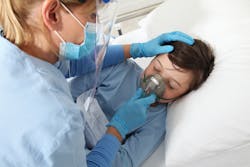Multi-system inflammatory syndrome is the storm that follows COVID-19 waves
While vaccines and continued public health measures are helping to control the COVID-19 pandemic and move us into a new normal, a troubling new syndrome has emerged. In the spring of 2020, doctors first noted a constellation of symptoms that suggested hyperinflammation and affected multiple organs at once in children, following exposure to or infection with SARS-CoV-2. The symptoms are not linked to any other microbial cause.
This syndrome was termed multi-system inflammatory syndrome in children MIS-C.1 As similar symptoms began to rise in adults,2 it prompted nomenclature that would include adults (MIS-A). At the population level, MIS cases appear to peak approximately one month after waves of elevated COVID-19 cases. While MIS is rare, it can be severe and require admission to the ICU. The underlying cause for MIS remains unclear, however, minimizing COVID-19 transmission using well-documented public health measures is a logical path towards better MIS management. In this article, we provide an overview of MIS and how communities can work to curb its prevalence.
MIS in the United States
As of November 1, 2021, the Centers for Disease Control and Prevention (CDC) reported approximately 5,000 cases of MIS-C out of approximately six million COVID-19 cases in children.3 So far, four MIS-C case peaks have occurred within the United States. Each MIS peak has followed a corresponding COVID-19 peak by approximately four weeks. Prior to the most recent COVID-19 wave in the summer of 2021, a relatively consistent relationship existed between the magnitude of COVID-19 and MIS-C spikes. But during the summer of 2021, MIS-C cases dropped to their lowest levels compared to COVID-19 cases. Researchers are still unsure why the pattern changed.
Sixty-one percent of the CDC’s reported MIS-C cases occur in non-Hispanic Black, Hispanic, or Latinx children. Additionally, similar to how COVID-19 has spread, most reported MIS-C cases are in male patients. Compared to adults and unlike the incidence of COVID-19, the inflammatory syndrome occurs more often in younger patients. The median age of reported cases is 9 years old, and half of the reported cases fall between 5 and 13 years old.
As we noted above, MIS has been more challenging to track in adults since the syndrome can be difficult to discern from other occurrences of COVID-19-related hyperinflammation. In spite of this, it is clear that MIS-A is rare, with only a few hundred reported cases2 as of this writing. Similar to MIS-C, MIS-A appears to cluster in younger patients. The median age of MIS-A patients2 is 21 years old and 50% of cases fall between 19 and 34 years old.4 Most MIS-A cases occur in male, non-white patients.4
MIS around the world
Apart from the United States, MIS also has been reported in Europe.5 As of this writing, experts at the World Health Organization (WHO) are unable to determine why cases appear to be concentrated in North America and Europe. More data will need to become available to fully understand the geographical occurrence of MIS.
How severe is MIS?
While MIS-C is rarely fatal, most patients experience severe symptoms and require aggressive treatment including ICU care and mechanical ventilation.6 Out of the 5,526 MIS-C cases reported as of November 1, 2021, there have been 48 deaths.3
Though severity estimates may be distorted by the difficulties in finding instances in adults, especially if the adult has pre-existing health issues, MIS-A looks to be more lethal than MIS-C. Researchers reported that 57% of MIS-A cases were admitted to intensive care, with 47% requiring respiratory support and 7% of patients losing their life.2
Signs and symptoms of MIS
Patients with MIS commonly exhibit the following symptoms.
- Fever (for four or more days).
- Gastrointestinal symptoms including nausea, vomiting, and diarrhea. In a recent study, a whopping 71% of MIS-C patients reported gastrointestinal problems
- Skin rash
- Sores in the mouth
- Conjunctivitis
- Low blood pressure, which may lead to shock
- Heart symptoms including inflammation in the tissue lining the heart and the heart tissue itself.
In more severe cases, heart symptoms associated with MIS may lead to heart and kidney failure. Heart failure accounts for a large portion of the overall mortality in MIS.
What triggers MIS?
The cause of MIS is still unclear. As mentioned above, nearly every case of MIS has been associated with prior SARS-CoV-2 infection or exposure and is usually not the result of some other microbe. In fact, patients consistently show a time course in which MIS symptoms follow several weeks after they themselves tested positive, had COVID-19 symptoms or were exposed to someone who did. MIS cases tend to arise about four weeks after the onset of COVID-19 symptoms.
One study looking at what might cause MIS suggests that an unknown superantigen associated with SARS-CoV-2 triggers an excessive and abnormal immune response. Researchers have shown that the immune systems of patients with severe MIS tend to have a specific phenotype.7 That phenotype is marked by increased and persistent immunoglobulin G (IgG) antibodies, a reduced white blood cell count, reduced neutrophil count, reduced total T cell count, and increased CD8+ T cell activation. CD8+ T cells are activated as part of the body’s antiviral response and are responsible for “killing” the viruses. The specific superantigen8 that triggers this heightened immune response is still unknown. Some researchers have suggested that components of the infamous SARS-CoV-2 spike protein might trigger the response, while others suspect unknown secondary microbes or opportunistic microbes (ones that typically might not cause disease but become pathogenic secondary to another infection), might be the culprit.
Another theory traces MIS symptoms to SARS-CoV-2 related antigens leaking from the intestines and into the bloodstream. A recent study found that MIS-C patients exhibit detectable virus within their stool several weeks after initial infection. Researchers suspect that the release of a protein called zonulin makes the gut “leaky” and, thus, allows the antigens to escape the intestines and into the bloodstream.9
While these studies offer some insight into why MIS may happen following COVID-19 infection or exposure, there is still a lot to learn.
How is MIS diagnosed?
Because the symptoms are non-specific, diagnostic criteria for MIS still varies from one institution to the next. Nonetheless, an American College of Rheumatology guideline10 states that if an individual has had a recent SARS-CoV-2 infection or exposure and reports an extended fever, skin rash, gastrointestinal symptoms, and conjunctivitis, it is likely they’re experiencing MIS.
Physicians evaluate these symptoms while considering other possible infections and other inflammatory diseases. Diagnostic studies might also include imaging and blood tests to study antibodies and blood cell counts. An echocardiogram might be used to study and diagnose heart dysfunction.
How is MIS treated?
Currently, there is little evidence that one optimal treatment works for treating MIS.
Nonetheless, treatment of MIS can be divided into two broad strategies:
- multi-system supportive care
- anti-inflammatory therapies.
MIS patients can present or develop complications in various systems. Thus, a multidisciplinary team of healthcare providers might be managing a case. Physicians may manage MIS patients using immune-modulatory therapy such as intravenous immune globulin (IVIG) and glucocorticoids.11 So far, these two treatments have been widely used to treat MIS with success.
Curbing MIS
Like COVID-19, there is still so much to discover about MIS in adults and children alike. Yes, the condition is rare, but there is very little to predict who might develop the syndrome beyond a prior or current positive COVID-19 test. And because it affects multiple organs with irregularity, it is more important than ever to work at slowing or preventing the spread of the virus.
During the thick of the COVID-19 pandemic and as the world reopened, widespread routine testing was critical for slowing the spread of the virus. The prevalence of free testing in many communities and accessible at-home testing measures can still help individuals self-quarantine or get COVID-19 treatment early. At a community level, detection of COVID-19 waves, through testing, can concurrently warn of an impending increase in MIS cases. At the individual-case level, knowledge of your COVID-19 status can help doctors determine if they should be looking for symptoms of MIS so it can be treated early.
Community surveillance using wastewater testing is helping cities catch large outbreaks early. All these tools have helped communities and countries to blunt the severity of the pandemic. In doing this, we can also curb the incidence of MIS. Collectively, the tools listed above have also helped to identify MIS and its relationship to COVID-19 and illuminated parallel cyclic patterns in COVID-19 and MIS cases.
In conclusion, though vaccination has dramatically improved the course of the pandemic, continued vigilance is important. MIS can be a severe, even life-threatening, condition, but like the broader pandemic, this syndrome can be prevented with broad testing and informed policy decisions that minimize virus spread.
References
1. Information for healthcare providers about multisystem inflammatory syndrome in children (MIS-C). cdc.gov. Updated May 20, 2021. Accessed November 1, 2021. https://www.cdc.gov/mis/mis-c/hcp/index.html
2. Patel P, DeCuir J, Abrams J, Campbell AP, Godfred-Cato S, Belay ED. Clinical characteristics of multisystem inflammatory syndrome in adults: a systematic review. JAMA Netw Open. 2021;4(9):e2126456. doi:10.1001/jamanetworkopen.2021.26456.
3. Centers for Disease Control and Prevention. Health Department-Reported Cases of Multisystem Inflammatory Syndrome in Children (MIS-C) in the United States. https://covid.cdc.gov/covid-data-tracker/#mis-national-surveillance. Updated November 1, 2021. Accessed December 2, 2021.
4. Morris SB, Schwartz NG, Patel P, et al. Case series of multisystem inflammatory syndrome in adults associated with SARS-CoV-2 infection — United Kingdom and United States, March–August, 2020. MMWR. 2020; 69(40);1450-1456. doi:http://dx.doi.org/10.15585/mmwr.mm6940e1.
5. World Health Organization. Multisystem inflammatory syndrome in children and adolescents temporally related to COVID-19. https://www.who.int/news-room/commentaries/detail/multisystem-inflammatory-syndrome-in-children-and-adolescents-with-covid-19. Published May 15, 2020. Accessed December 1, 2021.
6. Feldstein LR, Rose EB, Horwitz SM, et al. Multisystem inflammatory syndrome in U.S. children and adolescents. N Engl J Med. 2020;383(4):334-346. doi:10.1056/NEJMoa2021680.
7. Son MBF, Friedman K. COVID-19: Multisystem inflammatory syndrome in children (MIS-C) clinical features, evaluation, and diagnosis. UpToDate. Updated April 2, 2021. Accessed November 1, 2021. https://www.uptodate.com/contents/covid-19-multisystem-inflammatory-syndrome-in-children-mis-c-clinical-features-evaluation-and-diagnosis
8. Noval Rivas M, Porritt RA, Cheng MH, Bahar I, Arditi M. COVID-19-associated multisystem inflammatory syndrome in children (MIS-C): A novel disease that mimics toxic shock syndrome-the superantigen hypothesis. J Allergy Clin Immunol. 2021;147(1):57-59. doi:10.1016/j.jaci.2020.10.008
9.Yonker LM, Gilboa T, Ogata AF, et al. Multisystem inflammatory syndrome in children is driven by zonulin-dependent loss of gut mucosal barrier. J Clin Invest. 2021;131(14):e149633. doi:10.1172/JCI149633
10. Henderson LA, Canna SW, Friedman KG, et al. American College of Rheumatology clinical guidance for multisystem inflammatory syndrome in children associated with SARS-CoV-2 and hyperinflammation in pediatric COVID-19: Version 2. Arthritis Rheumatol. 2021;73(4):e13-e29. doi:10.1002/art.41616.
11. American Academy of Pediatrics. Multisystem inflammatory syndrome in children (MIS-C) interim guidance. aap.org. Updated October 2, 2021. Accessed November 1, 2021. https://www.aap.org/en/pages/2019-novel-coronavirus-covid-19-infections/clinical-guidance/multisystem-inflammatory-syndrome-in-children-mis-c-interim-guidance/
About the Author

Bruno Larida, MS, MBA
is Vice President of Marketing at Seegene Technologies. He brings more than 25-years of experience in the diagnostics industry, with knowledge in corporate management and global strategic marketing, expertise in product development, sales, and regulatory affairs.
